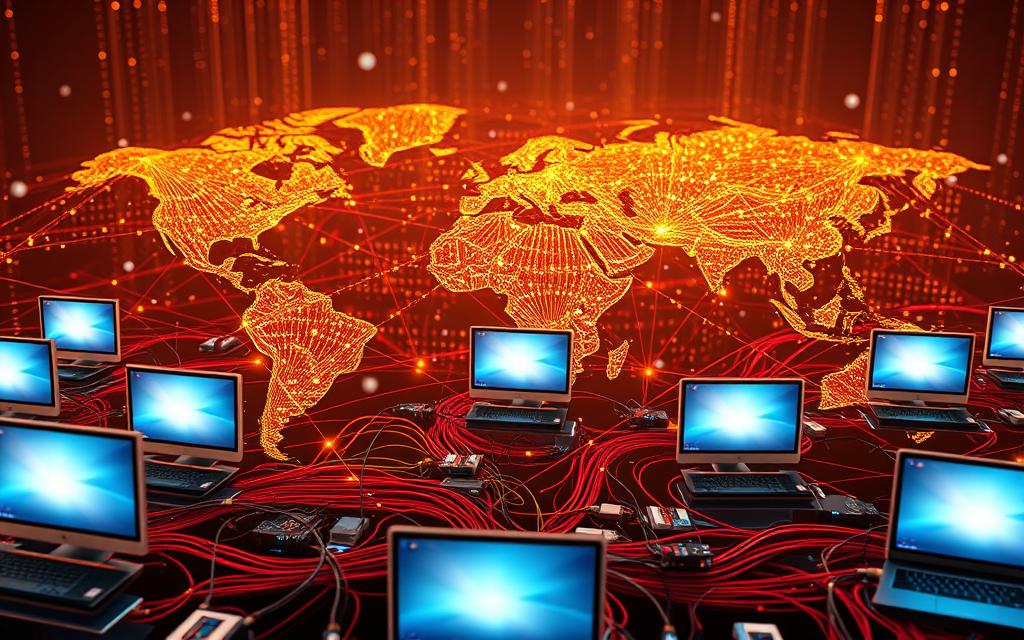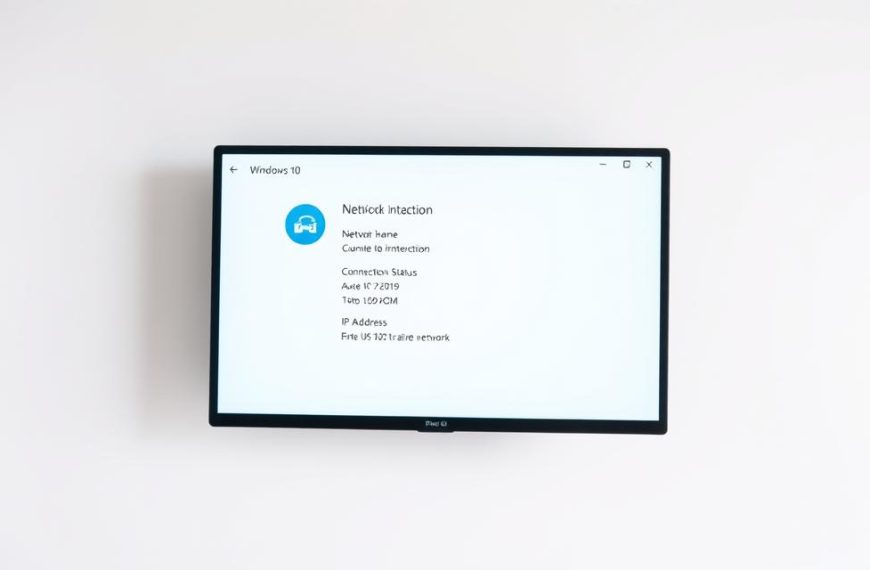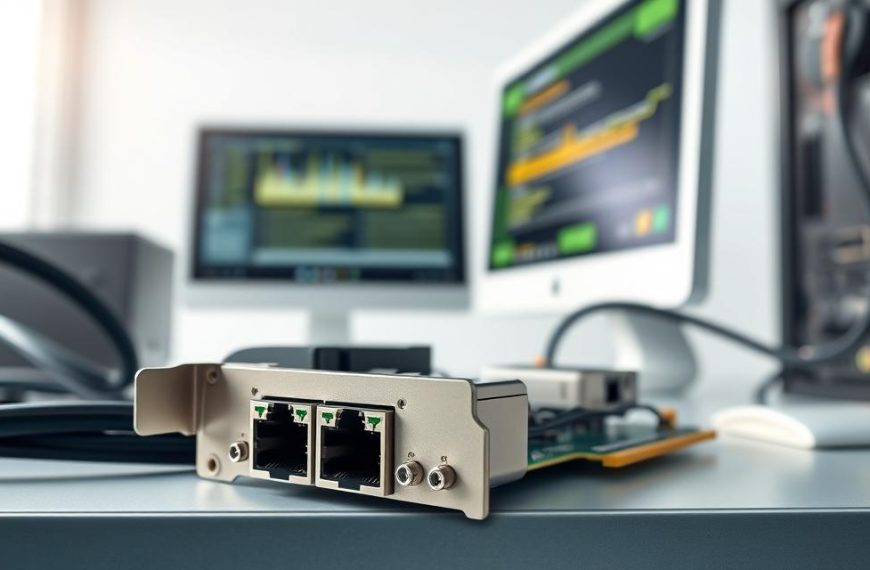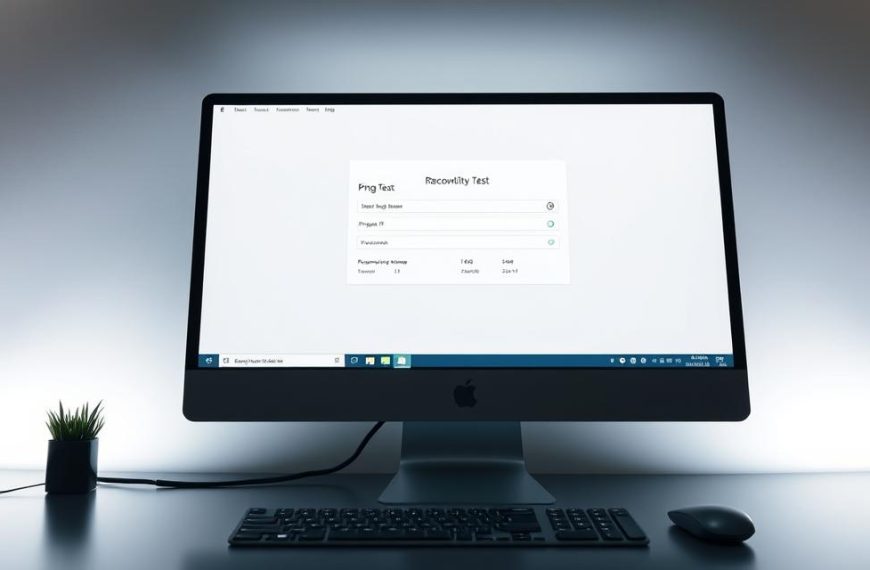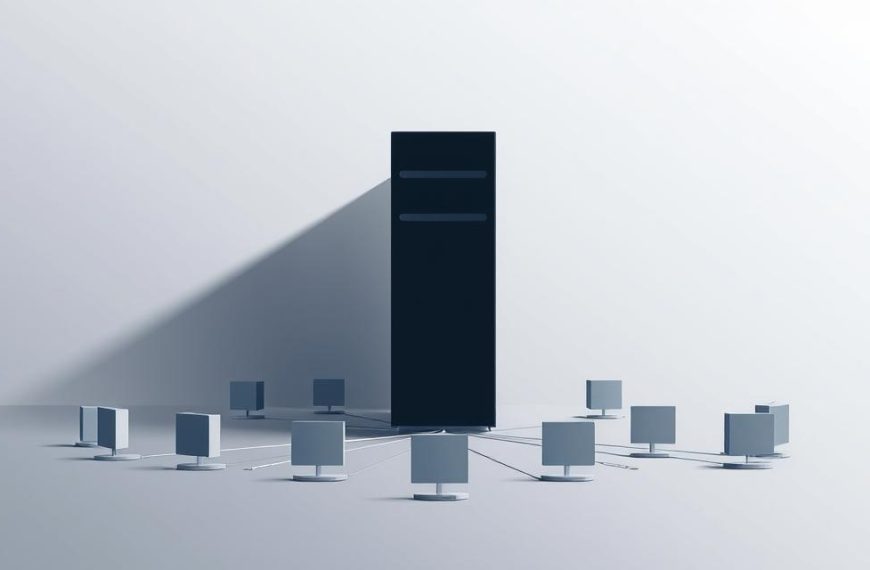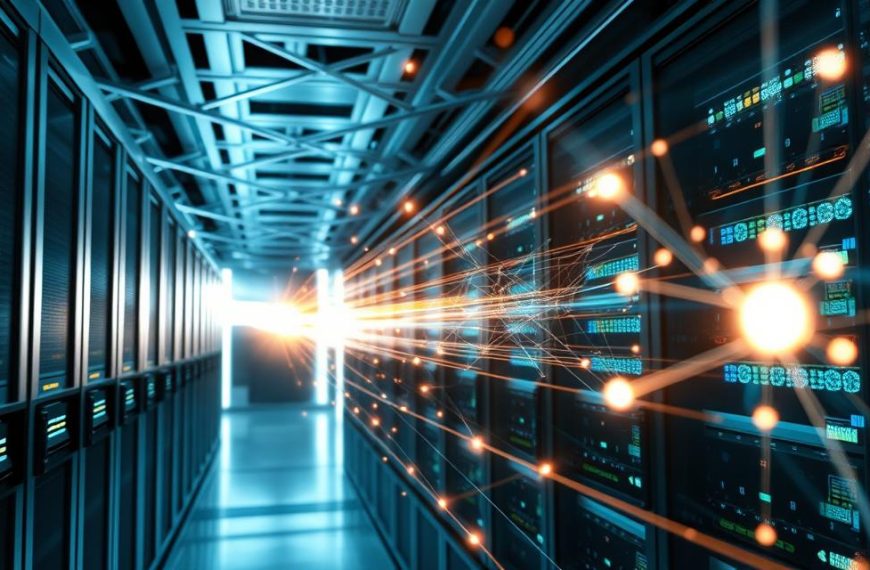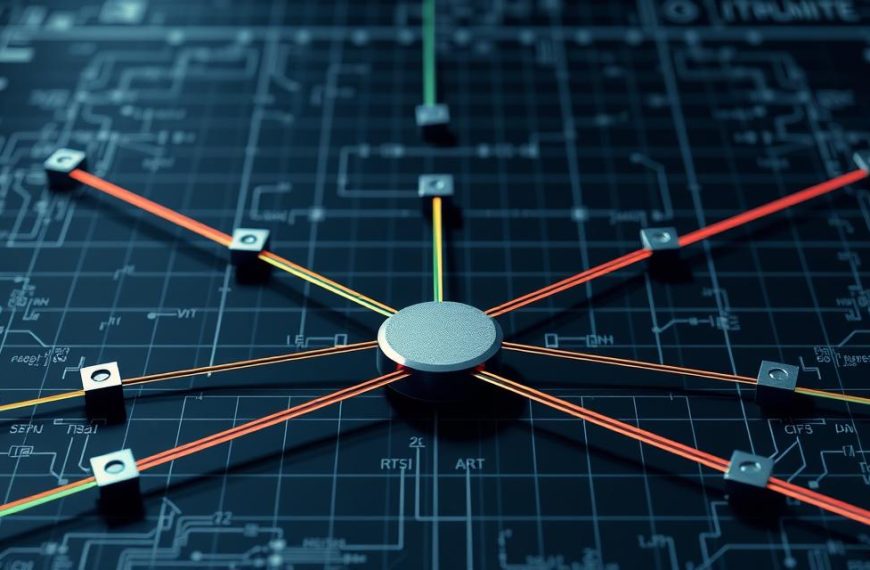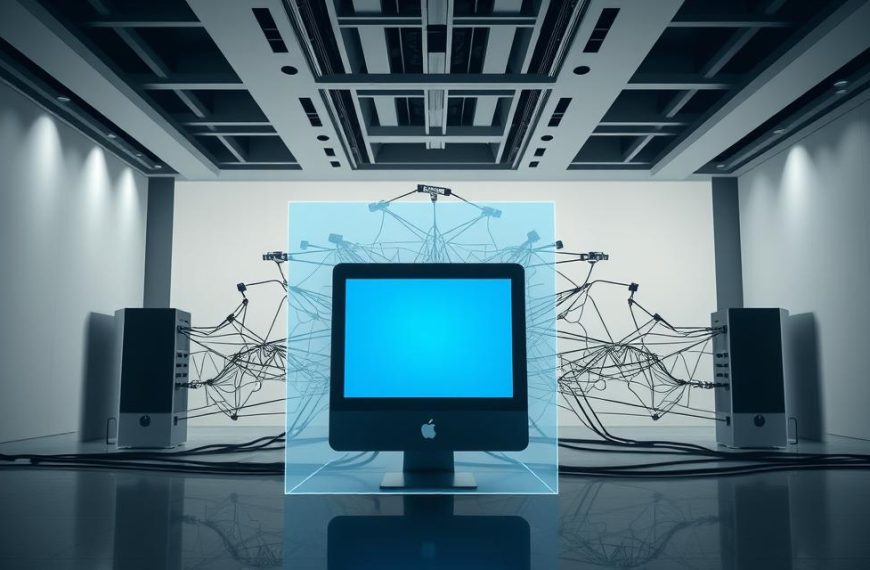Imagine a huge global network that links billions of devices worldwide. It’s the base of today’s digital connectivity. It lets us talk and share info instantly on a massive scale.
This network is made up of millions of interconnected computers. They use common rules to share data. Private, public, and government systems all play a part in this vast info exchange.
The system gives us online access to lots of things. From sending emails to watching videos, it supports our daily online activities.
Knowing what the internet definition is shows how info moves fast across the world. It’s key for business and personal talks in our connected lives.
Understanding What Is a Worldwide Computer Network
A worldwide computer network is a huge digital achievement. It connects devices all over the world into one big system. This web lets us talk and share information instantly, changing how we live and work.
The Fundamental Concept of Global Digital Connectivity
Global digital connectivity is a complex network of networks. It links computers, servers, and phones together. This system uses TCP/IP to talk to different devices, no matter where they are.
This network has both wired and wireless technologies. Under the sea, optical networking cables carry data. Satellites and radio waves help phones stay connected. Even wireless signals need physical paths to work.
Essential Characteristics of Worldwide Networks
Worldwide networks have key features that make them big and reliable. These traits set them apart from smaller networks.
- Decentralised architecture: No one controls the whole network. This makes it strong and keeps it running even if parts break.
- Standardised protocols: Rules like TCP/IP let different systems talk to each other easily.
- Hybrid infrastructure: A mix of wires, optical networking fibres, and wireless technologies makes data paths strong.
- Scalability: The network can grow without needing big changes.
These features help the internet support billions of users. It keeps working well, even with lots of different uses.
The Historical Development of the Internet
The journey from isolated computer systems to today’s interconnected digital world is remarkable. It didn’t happen overnight but took decades of innovation and vision.
This development shows us the complex infrastructure behind our daily digital interactions. It started in the Cold War era and grew into the global network we use today.
From ARPANET to Global Network
The internet started with ARPANET, a project by the US Department of Defense in the 1960s. It aimed to create a strong communication system during conflicts.
In October 1969, the first successful message was sent between UCLA and Stanford Research Institute. This was a big step in networked communication, even though the first message, “LOGIN”, was cut off.
Packet switching technology was key to ARPANET’s success. It breaks data into packets that travel independently and reassemble at their destination. This was better than traditional systems.
In the 1970s and 1980s, ARPANET grew from a small network to a bigger system. The use of TCP/IP in 1983 made different networks talk to each other. This was a big step towards the modern internet.
TCP/IP allowed networks to connect and share information easily. This change was a turning point, making the internet bigger than before.
The World Wide Web Revolution
By the 1980s, the internet was growing, but it was hard for non-experts to use. This changed with Tim Berners-Lee‘s idea in 1989.
Berners-Lee worked at CERN and wanted a system for sharing documents easily. He combined several technologies into a new framework.
The World Wide Web brought three key technologies:
- HTML (HyperText Markup Language) for web pages
- URI (Uniform Resource Identifier) for addressing content
- HTTP (Hypertext Transfer Protocol) for data transmission
The first web browser, WorldWideWeb, came out in 1990. It made it easy to navigate between documents with hyperlinks. This made information more accessible to everyone.
CERN made the World Wide Web free in 1993. This led to a lot of new websites and services in the 1990s.
| Year | Milestone | Significance |
|---|---|---|
| 1969 | First ARPANET connection | Established first computer network link |
| 1983 | TCP/IP adoption | Created standard internet protocol |
| 1989 | World Wide Web proposal | Introduced hypertext system concept |
| 1993 | Web technology made free | Enabled rapid global expansion |
The internet grew fast because of its technical base and easy-to-use interface. This partnership made the internet popular worldwide.
Today, the internet keeps evolving. But its core architecture is based on the work of pioneers like Tim Berners-Lee and ARPANET researchers. Their vision supports innovation even today.
Technical Infrastructure Supporting the Internet
The internet works smoothly thanks to a complex system of hardware and digital rules. This system helps us stay connected in our digital world.
Physical Components: Cables, Routers and Data Centres
The internet’s core is made of physical parts. Fibre optic cables carry data using light pulses. They are faster than old copper wires.
Routers manage data traffic. They decide the best path for data to travel. This ensures data gets to its destination quickly.
Data centres store websites and apps. They have special cooling and power systems. This keeps them running all the time.
Protocols and Communication Standards
Digital rules help different systems talk to each other. The Internet Protocol (IP) gives each device a unique IP address.
Transmission Control Protocol (TCP) works with IP. It makes sure data is delivered right. It checks for errors and sends data again if needed.
The Domain Name System (DNS) is like a phonebook. It turns domain names into IP addresses that computers can understand. This makes the internet easy to use.
Hypertext Transfer Protocol (HTTP) helps web pages load. It defines how messages are sent between browsers and servers. This makes the web work smoothly.
| Infrastructure Component | Primary Function | Key Characteristics |
|---|---|---|
| Fibre Optic Cables | Data transmission medium | High bandwidth, low latency, long-distance capability |
| Routers | Network traffic direction | Packet analysis, path optimisation, connectivity management |
| Data Centres | Content hosting and storage | High availability, security, scalability, redundancy |
| IP Addressing | Device identification | Unique numerical labels, hierarchical structure, routing enablement |
| DNS System | Domain name resolution | Distributed database, name-to-address translation, caching |
These parts work together to support our digital lives. They keep the internet fast and reliable. As technology grows, so does the internet’s ability to handle it.
How Information Travels Across the Global Network
The internet moves information across continents fast, thanks to advanced digital systems. These systems make sure your emails, videos, and web pages get to you quickly. They work well, no matter how far away they are.
Packet Switching and Data Transmission
When you send something online, it breaks into smaller pieces called data packets. Each packet has a bit of your data and info to find its way to you.
This method is better than old ways of sending messages. Networks can change paths for packets if needed. This means packets can find new ways if the first one is blocked.
“Packet switching made big networks possible. It uses network resources well and is fault-tolerant.”
Packets go through several steps:
- They are broken into smaller pieces
- They get addresses and sequence info
- They travel through the network
- They are put back together at the end
IP Addressing and Routing Systems
Every device on the internet has a unique IP address. This IP addressing system is like a digital postal service. It helps packets find their way to the right device among billions.
Routers are like traffic cops for the internet. They check packet addresses and pick the best routing paths. They keep up with network changes to forward packets efficiently.
| Address Type | Format | Primary Use | Capacity |
|---|---|---|---|
| IPv4 | 192.168.1.1 | Original addressing standard | 4.3 billion addresses |
| IPv6 | 2001:0db8:85a3::8a2e:0370:7334 | Modern expanded addressing | 340 undecillion addresses |
| Dynamic IP | Changes periodically | Consumer devices | Temporary assignment |
| Static IP | Remains constant | Servers and websites | Permanent assignment |
The client-server model is how most internet use works. Your device is the client, asking for info. Servers handle these requests and send back what you need. This setup makes things run smoothly and efficiently.
When you visit a website, your browser sends a request. The server then sends back the info as packets. This whole process is usually very quick, showing how well digital networks work.
Major Services and Applications Facilitated by the Internet
The internet has changed how we talk, learn, and live our daily lives. It brings us closer together and makes things easier. We can now access information and communicate with people all over the world.
https://www.youtube.com/watch?v=tq9Yp8kAaTk
Digital Communication Platforms
Internet-based platforms have changed how we talk to each other. Email is a key tool for work and personal chats. It lets us send messages whenever we want.
Sites like Facebook, Twitter, and Instagram have created online communities. Here, people share their lives and ideas instantly. They help us make friends and find work.
Apps like WhatsApp and Telegram make talking easy with text, voice, and video. Tools like Zoom and Microsoft Teams are key for working from home. They help us meet and work together online.
“The internet has erased geographical boundaries, creating a global village where communication happens at the speed of light.”
Information Access and Online Resources
The internet is a huge library of knowledge. We can find answers and learn new things through search engines and educational sites. Wikipedia is a great source of information on many topics.
Platforms like Coursera, Khan Academy, and edX offer online courses from top schools. They make learning easy and accessible to everyone. This has changed how we learn and grow.
Services like Netflix, Spotify, and YouTube give us endless entertainment. News sites and online papers keep us up to date with what’s happening in the world.
Cloud storage like Google Drive and Dropbox help us manage files and work together. They make it easy to share documents and work as a team, even when we’re apart.
| Service Category | Primary Functions | Key Examples | User Benefits |
|---|---|---|---|
| Communication | Messaging, video calls, community building | Email, social media, Zoom | Real-time interaction, global reach |
| Information Access | Knowledge sharing, education, news | Wikipedia, Coursera, BBC News | Continuous learning, current awareness |
| Entertainment | Streaming, gaming, content creation | Netflix, Spotify, YouTube | On-demand access, diverse content |
| Productivity | File storage, collaboration, remote work | Google Drive, Microsoft 365 | Efficiency, accessibility, teamwork |
The internet offers many online services for different needs. From work tools to fun sites, it keeps getting better. It helps us in many ways, making our lives easier and more fun.
The computer network lets these services work. It ensures our data gets where it needs to go quickly. This tech helps us do everything from simple emails to big projects online.
The Internet’s Transformative Impact on Society
The digital revolution has changed how societies work and interact globally. It has affected our economy, social behaviour, and culture. The internet is now a key part of our modern world, changing business, relationships, and how we find information.
Economic and Business Evolution
The internet has brought big changes to the economy. Old business models have been shaken up, and new ones have appeared. This has led to the digital economy, where digital platforms and services are key to making value.
E-commerce has changed how we shop. Businesses of all sizes can now sell to people all over the world. Online stores have made it easier for small businesses to compete with big ones. Mobile shopping has also become very popular.
The internet has also changed how we work. It has made remote work and digital teamwork possible. Finance and manufacturing have seen big changes, using data and cloud computing to improve. This has created new jobs but also made some old ones less important.
Social and Cultural Transformations
The internet has also changed how we socialise and express culture. It has changed how we talk, make friends, and join communities. This has brought people together but also raised issues about privacy and fake news.
Online communities have formed around shared interests. They connect people worldwide, sharing knowledge and supporting each other. These communities have helped with social issues but can also highlight cultural differences.
The cultural impact of the internet is seen in how we enjoy entertainment and news. It has made it easier for people to create and share content. This has made culture more diverse but also raised questions about quality and rights.
Education has also changed with online learning. It has made learning easier than ever. Civic engagement has evolved with digital activism and online campaigns. The internet has deeply influenced how we learn, participate, and express ourselves.
Conclusion
The internet is a key part of our modern world, acting as a global network. It has made connecting with others worldwide easier and faster. From its start in ARPANET to now, it has grown a lot, linking people across the globe.
The future of the internet looks bright, with new tech like IoT, AI, and 5G. It’s changing how we live, work, and learn. The internet is now a big part of our daily lives, helping with shopping and learning online.
Looking back, the internet has had a big impact on us. It’s changed how we communicate and access information. As we move forward, we must keep improving it, making sure it’s safe and open to all.

